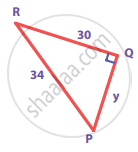Advertisements
Advertisements
प्रश्न
In the given figure, ABC is a triangle in which ∠ABC < 90° and AD ⊥ BC. Prove that AC2 = AB2 + BC2 − 2BC.BD.

उत्तर
Applying Pythagoras theorem in ΔADB, we obtain
AD2 + DB2 = AB2
⇒ AD2 = AB2 − DB2 … (1)
Applying Pythagoras theorem in ΔADC, we obtain
AD2 + DC2 = AC2
AB2 − BD2 + DC2 = AC2 [Using equation (1)]
AB2 − BD2 + (BC − BD)2 = AC2
AC2 = AB2 − BD2 + BC2 + BD2 −2BC × BD
= AB2 + BC2 − 2BC × BD
APPEARS IN
संबंधित प्रश्न
Prove that the points A(0, −1), B(−2, 3), C(6, 7) and D(8, 3) are the vertices of a rectangle ABCD?
Some question and their alternative answer are given. Select the correct alternative.
If a, b, and c are sides of a triangle and a2 + b2 = c2, name the type of triangle.
Diagonals of rhombus ABCD intersect each other at point O.
Prove that: OA2 + OC2 = 2AD2 - `"BD"^2/2`
In ∆ ABC, AD ⊥ BC.
Prove that AC2 = AB2 +BC2 − 2BC x BD
In a triangle ABC right angled at C, P and Q are points of sides CA and CB respectively, which divide these sides the ratio 2 : 1.
Prove that : 9(AQ2 + BP2) = 13AB2
Find the unknown side in the following triangles
The hypotenuse of a right angled triangle of sides 12 cm and 16 cm is __________
From the given figure, in ∆ABQ, if AQ = 8 cm, then AB =?

Lengths of sides of a triangle are 3 cm, 4 cm and 5 cm. The triangle is ______.
Two trees 7 m and 4 m high stand upright on a ground. If their bases (roots) are 4 m apart, then the distance between their tops is ______.
